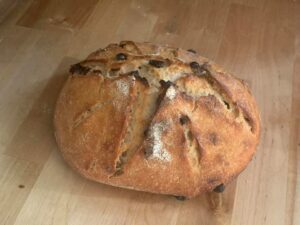
There’s been a big lockdown craze of creating our own sourdough starters for baking bread. If you’re not familiar with what this process is I’ll explain.
All breads use yeast to rise. Most bread these days are produced by using commercial yeast you buy in packets in the stores.
Prior to the commercialization of the yeast and flour industry all bread was really ‘sourdough’. Bakers kept and maintained ‘starters’ which is a mixture of flour and water that feeds wild yeast. These starters are kept alive indefinitely by continuing to feed them with additional flour and water. Some starters I’ve researched have been kept alive for generations.
A starter is created by mixing water and flour and letting it sit out to ferment. The yeast that’s on the grains in the flour, and sometimes ones just in the air, feed on the flour and reproduce. Since wild yeast is present in all flour, the easiest way to make a starter is simply by combining flour and water and letting it sit for several days. You don’t need any fancy ingredients. You feed and maintain this mixture with fresh flour and water over the next several days, for about a week until it’s bubbly and “billowy”. Once it reaches that frothy stage your colony of yeast is strong enough to rise a loaf of bread or whatever you’re baking. You can then maintain this starter indefinitely and use it in place of commercial yeast. The flavor is much bolder than typical white bread, and heck all you need to make bread then is flour and some salt!
Some people make their own starters this way, or they are given part of someone else’s starter as a ‘seed’ to start their own. By keeping it alive with regular feedings and slowing down their expansion by keeping it in the fridge, you can feed it once a week and keep it going forever.
Lawton Clites, a regular fixture on our site as there’s nothing he can’t do, sent me these tips and the picture of his bread.
Tips (feel free to use or skip whichever you need).
Mix the dough wetter than you think you need Allow to ferment/rise longer than you think you need. Bake the first 30 minutes in a cast iron Dutch oven for extra bagel-y crust.
Add flavors:
Cinnamon raisin
Raisin Caraway Seed
Caraway Seed
Fresh Rosemary
Roasted Garlic
